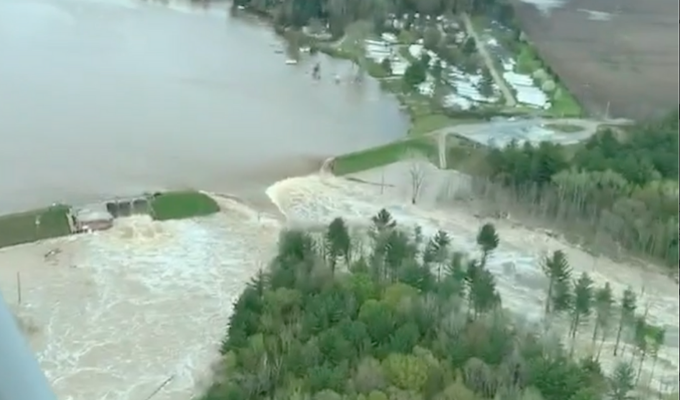“Supercharging” river restoration: a landmark bill to boost dam removal nationwide

This blog was written by Ted Illston and Brian Graber.
The impacts of climate change — felt first and hardest on rivers and water resources in the form of floods and droughts — threaten fragile ecosystems, public health and safety, cultural heritage, our economy and our future. It’s why restoring healthy, free-flowing rivers must be a top priority for Congress and the Biden administration. It’s also why we must chart a smart course for hydropower: a source of energy that may be low-emission but often comes with a high price for river health.
Today, our efforts to ensure a future of healthy rivers and climate resilience took a major step forward.
Representative Annie Kuster (NH-02) introduced legislation that advances the environmental, safety, and economic benefits of healthy rivers and charts a course for hydropower in our nation’s future. The bill, which provides $24.8 billion in spending over 5 years, is designed to accelerate the rehabilitation, retrofit, or removal of the nation’s more than 90,000 dams. Rep. Kuster was joined by Representatives Don Young (AK-AL), Kim Schrier M.D. (WA-08), Julia Brownley (CA-26), Jared Huffman (CA-02), Debbie Dingell (MI-12), Emanuel Cleaver (MO-05), Nanette Diaz Barragán (CA-44), and Bonnie Watson Coleman (NJ-12) in introducing this legislation today. Sen. Dianne Feinstein (D-CA) will introduce companion legislation in the Senate later this month.
This bill is urgent and timely, as Congress and the Biden administration consider national infrastructure legislation. Dams are a major component of our nation’s infrastructure – and many are outdated and unsafe. The American Society of Civil Engineers gave dams a “D” grade on its report card on America’s infrastructure. The failure of Michigan’s Edenville Dam last year, and the spillway breach at California’s Oroville Dam in 2017, raised the alarm about the safety of dams in the U.S. An element of the legislation is critical investment to protect the public from the ticking time bombs of unsafe dams.

American Rivers played a key role in crafting the legislation, with vital partnership from organizations including the Association of State Dam Safety Officials, American Whitewater, Trout Unlimited, The Nature Conservancy, Hydropower Reform Coalition, Low-Impact Hydropower Institute, National Hydropower Association, and others.
If enacted, the bill – which is not focused on any particular U.S. dam, river or region – would restore more than 10,000 miles of rivers by enhancing their climate resilience through the rehabilitation or removal of hundreds of the nation’s most hazardous dams. The legislation would also secure the nation’s existing hydropower dams by improving their performance, resilience, and safety. Additionally, it would provide a significant investment in existing federal dams to enhance environmental performance and improve dam safety. Collectively, these efforts will support or create approximately 500,000 jobs.
Key elements of the legislation include:
- Increase federal financial assistance to improve dam safety – $9.75 billion total over 5 years.
- Leverage the federal tax code to incentivize investments in dam safety, environmental improvements, grid flexibility and availability, and dam removal – $4.71 billion for a 30% Tax Credit.
- Create a public source of climate resilience and conservation funding for removal of dams that have reached the end of their useful life – $7.5 billion over 5 years. (Because federal hydropower dam removals require individual negotiations and usually Congressional authorization, they are excluded from this bill’s dam removal funding, but all other dams are eligible.)
- Invest in existing federal dams and relevant research programs to accelerate decarbonization, increase renewable power generation, enhance environmental performance, improve dam safety, leverage innovative technologies, and evaluate disposition – $12 billion over 5 years (combination of $11 billion for dam-owning federal agencies and $1 billion for research).
American Rivers and our partners crafted the legislation as a complete package, and it is essential that these pieces remain whole and connected as the bill moves through Congress.
Since 1912, more than 1,700 dams have been removed nationwide, restoring thousands of miles of rivers. The river restoration movement in the U.S. is stronger than ever, yet there is simply not enough funding to advance all of the projects that are needed for public safety and river restoration. With this legislation, we’re poised to supercharge dam removal – taking river restoration to the next level, with a multitude of benefits for communities nationwide. We’re also acknowledging there is a role for hydropower in our energy future, as long as we balance smart hydro with our need for healthy, free-flowing rivers.
It’s also important to note that American Rivers is unwavering in our support and advocacy for a critical river restoration effort that is not included in this legislation – the effort to remove the four dams on the lower Snake River in the Pacific Northwest, to save endangered salmon and orca. American Rivers views the Twenty-First Century Dams Act, and the effort to restore the Snake River – which we named America’s Most Endangered River® of 2021 — as top priorities and both must move forward.
We urge you to contact your elected officials and urge them to support both of these vital river restoration efforts.
The post “Supercharging” river restoration: a landmark bill to boost dam removal nationwide appeared first on American Rivers.


